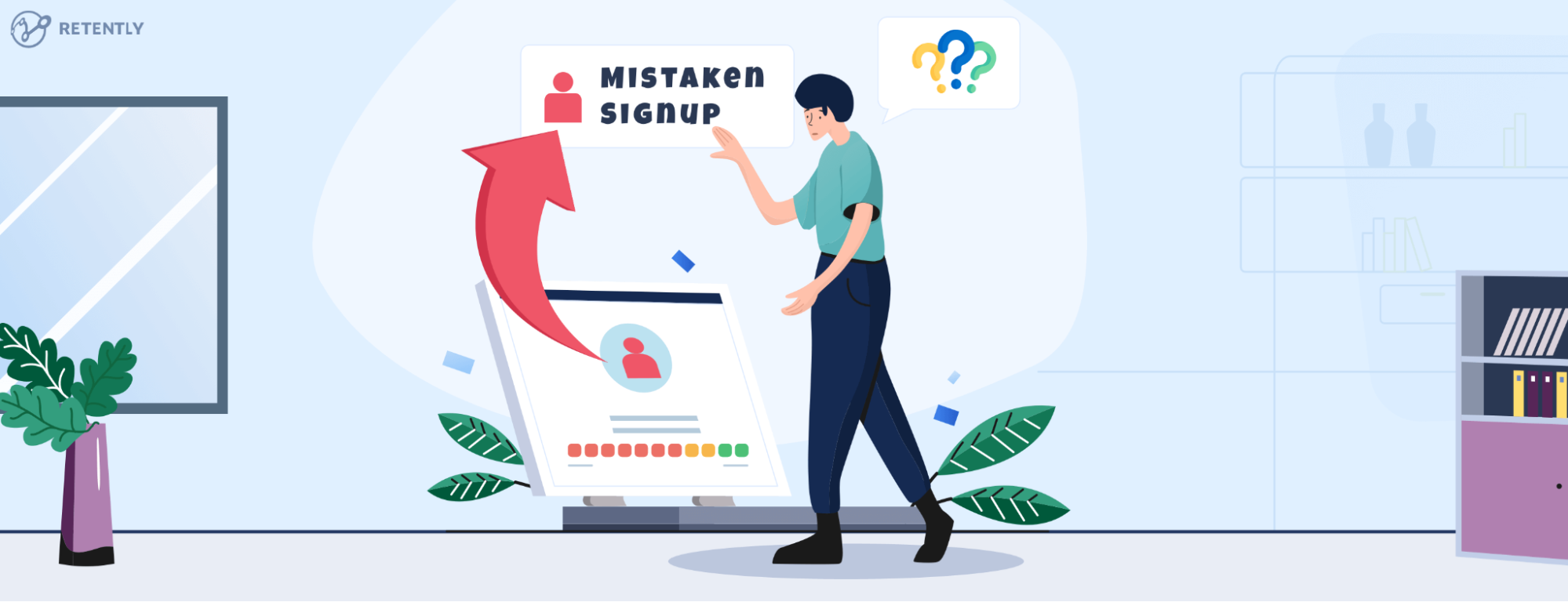Search online for information on increasing your SaaS products’ conversion rate and you’ll find page after page countless techniques designed to help you convert more of your visitors into trial users and paying customers.
Often, these tactics are successful — when implemented effectively, they can boost your conversion rate and increase your visitor-to-trial-user conversion rate. But by solving one problem, it’s quite easy to create another: customers who sign up for your product without really needing it.
We call these users “mistaken signups” since they’re often mistaken into thinking your SaaS product is essential for their business when, in reality, it might not be a good fit for a variety of reasons.
Of course, we don’t mean “mistaken signups” in a pejorative sense — these customers didn’t do anything wrong or make a critical mistake. Instead, they signed up for your trial or bought your product by mistake, either due to a marketing issue or another factor.
Usually, this is a completely innocent consequence of a mismatch between a customer’s expectations and the reality of your product, or a result of a friend or a colleague recommending your SaaS product when it might not have been necessary.
For the most part, mistaken signups aren’t a major liability for your business. They’ll usually sign up for your free trial (or, if your product doesn’t offer a free trial, buy a short-term plan) and cancel once they realize your product isn’t right for them.
At best, your business has a missed opportunity; at worst, a quick and simple refund. However, mistaken signups can cause difficulties for your business when they leave feedback in your Net Promoter Score® survey that doesn’t accurately reflect genuine customer sentiment.
How a Mistaken Signup Can Affect Your NPS
Most of the time, mistaken customers will quietly and politely cancel their subscription to your SaaS product. However, if you use Net Promoter Score software to track customer sentiment and collect feedback, mistaken signups can be something of a liability, as well as a source of confusion when it comes to calculating your NPS.
When mistaken customers receive and respond to your NPS survey, the feedback they leave tends to be negative. In short, they’re Detractors, even though they likely never invested their time into truly using your product in the way it’s intended.
As such, their feedback can feel almost like an anchor that artificially weighs down your Net Promoter Score.
No one likes receiving a review that feels unfair, and no reviewer who doesn’t truly use your product can provide an honest appraisal. But is their feedback still valuable, and should you keep their score in your NPS calculations?
We think so, albeit with one caveat (which we’ll cover a little later).
Mistaken Signups Can Help You Master Onboarding
Often, customers who mistakenly sign up for your product and cancel without truly using it do actually need it — they just never make it through your onboarding process.
If your SaaS product has a steep learning curve (that is, it’s difficult to find your way around the key functions and features as a first-time user), your onboarding process needs to guide users through the process of getting up and running.
This is especially important if your product is aimed at a non-technical audience, such as small business owners or beginners to running and growing an online business.
Techies and people who already understand the value of your product will usually tolerate an onboarding process that isn’t entirely smooth. Some will even leap right into a minimum viable product with no onboarding at all, provided the features are useful.
Most users, however, need to have their hands held. If you’ve noticed a lot of customers that sign up for your SaaS free trial or buy a short-term subscription with good intentions but then cancel quickly, your onboarding process could be the obstacle that’s turning them away. As a matter of fact, poor onboarding is one of the three leading causes of customer churn, being responsible for 23% of average customer churn.
The solution to this problem? Identify onboarding weaknesses using A/B testing and the feedback from Detractors, then prepare a step-by-step strategy to eliminate onboarding hurdles that turn enthusiastic would-be users into quick-to-cancel Detractors.
Mistaken Signups Can Help You Identify Marketing Issues
Another key benefit of paying attention to NPS survey feedback from mistaken signups is that it can help you identify weaknesses in the way you market your product.
The most common marketing weakness exposed through feedback from mistaken signups is a mismatch between what your marketing message says your product does and what it actually does.
For example, pretend for a moment that you sell a SaaS product, specifically CRM software, that helps small online stores grow their sales. Your on-site copy, ads, and testimonials reflect a best-case scenario — rapid business growth and a doubling, tripling, or even quadrupling of revenue in just a few months.
Now, this might not be a misleading claim. Customers might have used your product and truly achieved rapid growth by fixing readily fixable weaknesses. But it could also result in mistaken signups, like a store owner who doesn’t sell goods online, feeling misled or disappointed when they sign up for the service, invest some time to get familiar with it, only to realize it doesn’t fit their business model at all.
Another common marketing issue that can lead to mistaken signups and poor NPS feedback is a “let’s market to everyone” approach.
If your SaaS product is built specifically for startups with in-house technical staff, scaling your marketing efforts to reach less technically-minded customers could lead to a higher number of free trial signups canceled without ever using your product.
Or, if your product is designed solely for businesses with 1,000 or more employees, failing to mention this fact in your on-site copy or inbound marketing content could result in a surge of mistaken signups from small business owners who simply aren’t your target customers.
In either situation, the result is the same: a missed opportunity, a Detractor and a Net Promoter Score that’s pushed downwards by feedback from a customer who didn’t use your product as intended.
The solution to this problem? Dig into feedback from fast-to-cancel Detractors to identify what determined them to leave. Then audit your marketing approach to identify anything that could result in a mismatch between a potential customer’s expectations and reality.
Mistaken Signups Can Help You Identify Poor Support or a Weak Knowledge Base
Finally, many quick-to-leave users end their trial or cancel their subscription not because they don’t need your product or have a problem with its marketing, but because they can’t find the answers they need when needed.
No matter how tech-savvy your target audience is or how effective your onboarding process may seem at showing customers around your SaaS product, there will inevitably be situations where your customers will need help working out a feature or solving a problem.
When this happens, whom can they turn to? If your live support isn’t available, they might scour your knowledge base for an answer. If the information they’re seeking isn’t there, the next most likely step is an email to your support team.
By this point, it’s easy for a free trial user or short-term subscriber who could have become a loyal customer to give up on your product entirely.
The solution to this problem? Just like the two situations outlined above, the key to turning this event into an opportunity is to analyze and act on the customer’s feedback. Is information missing from your knowledge base? Is your support as readily available as it should be?
It only takes a minor roadblock to turn a new user away from your SaaS product, which is why the vast majority of free trial users fail to turn into paying customers.
Look into the NPS feedback from mistaken signups — just as thoroughly as you would the input from your loyal subscribers — and you’ll find it far easier to identify opportunities to reduce accidental signups and improve your trial-user-to-paying-customer conversion rate.
The Caveat
As mentioned earlier, there’s a caveat to including qualitative and quantitative data from mistaken signups when calculating your NPS score.
The caveat is that while you should take feedback from mistaken signups very seriously when it comes to marketing, onboarding, and support, there’s not much value in looking too deeply into product-specific feedback from people who buy your product accidentally.
Often, a mistaken or accidental customer’s first instinct is to offer sweeping criticism of your product in their NPS feedback. Instead of explicitly pointing out the onboarding or marketing failure that caused their cancellation, they’ll criticize your product or business as a whole.
Similar to other qualitative NPS feedback, the solution is to be selective about how you analyze and act on customer feedback. Take specific, actionable complaints seriously and turn them into improvement priorities, but don’t fret over nonspecific, unhelpful, or rude Detractors.
Boost Satisfaction and Retain More Customers With Retently
Retently is designed to make implementing Net Promoter Score easy, letting you learn more about how customers feel about your product, identify weak points that determine user cancellations and make real improvements in increasing your retention rate.
Net Promoter Score can help your company retain customers and grow at a faster pace, so sign up for your free Retently trial and start surveying your customers for actionable feedback and insights.






























 Greg Raileanu
Greg Raileanu 

 Alex Bitca
Alex Bitca 


